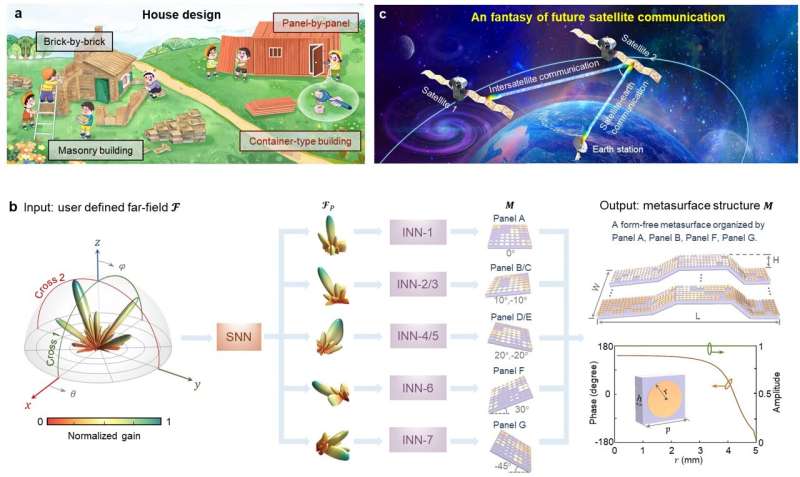A knowledge-inherited learning for intelligent metasurface design and assembly

The interaction of machine learning and optics/photonics is transforming the way we design new photonic structures, unearth latent physical laws, and develop intelligent photonic devices. Despite certain achievements, a major impediment persistently exists; datasets and networks are only disposable.
Thus, for each new state or task, all datasets and networks have to be discarded, and it is imperative to reconstruct new datasets and networks, leading to an enormous waste of resources. In machine learning-based metamaterial designs, much effort has been inaugurated to enlarge the training dataset or construct specific networks. Either way, each metamaterial is physically separated, and the data utilization efficiency is very low.
Therefore, it is highly desirable to exploit whether there are any physical connections or network correlations among various metamaterials that can robustly handle a broad range of metamaterials.
In a new paper published in Light Science & Application, a team of scientists, led by Professor Hongsheng Chen from State Key Laboratory of Modern Optical Instrumentation, Zhejiang University, China, and co-workers have developed a knowledge-inherited neural network for metasurface inverse design and wireless applications in a “green” manner.
As its name implies, such a network can inherit the knowledge from “parent” metasurfaces, and then freely assemble for “offspring” metasurfaces. This inheritance-to-assembly mixture scheme is analogous to building a container-type house. In other words, this method bridges the metasurface assembly in physical space to the synthesis of the neural network. Such a paradigm breaks a long-standing stereotype that neural networks only work for predefined and shape-bound objects.
Further, they benchmark the universality of this paradigm by one aperiodic metasurface and three periodic stretchable origami metasurfaces with an accuracy of over 86.7%, in stark contrast to 20.0% that was achieved by conventional neural network. More interestingly, the successful design and solid experiment of intelligent origami metasurfaces usher in an innovative spaceborne antenna for future satellite communication.
The reported method and technique will open up a new avenue for automatic metasurface design and leverages the assemblability to broaden the adaptability of intelligent metadevices.
Different from conventional “brick-by-brick” neural network whose input–output parameters are predetermined and fixed, the reported “panel-by-panel” method endows the network recyclability and flexible assimilability, analogous to building a container-type house with high flexibility and free assembly. The knowledge-inherited paradigm is composed of two functional networks, i.e., an inherited neural network (labeled INN) and an assembled neural network (labeled SNN).
The INN is responsible for the inverse design of each ‘panel’ metasurface, and the SNN functions as a deployer to assign the task for each INN. These scientists summarize the operational principle of their network:
“The database consists of seven ‘panel’ metasurfaces, each of which has its own INN. For a given metasurface, such as a rectangle and a diamond-shape, we first construct it with these seven ‘panel’ metasurfaces in physical space, and then synthesize the holistic neural network by using the handy-prepared INN. In this procedure, the INN is completely inherited and reserved, and instead, we only need to dynamically adjust the SNN, enabling a green and data-efficient metasurface inverse design.”
“Due to the inimitable physical character of metasurfaces, our knowledge-inherited network is associated with the complex spatial information of structures, which can further inherit the knowledge from ‘parent’ metasurfaces, and then freely assemble for ‘offspring’ metasurfaces. In other words, the synthesis of networks in the virtual space is inseparably correlation to the metasurface assembly in physical space,” they added.
“In practice, by applying our inheritance-to-assembly strategy, we can also achieve multi-stage network assembly for larger or more complex models.”
“Another point we would like to emphasize is that the advantages of ‘panel-by-panel’ are extremely maximized in the application of geometrical periodic metasurfaces, such as origami metasurfaces. Attached with external force stimulation, origami structures can smoothly dominate their folding/unfolding movement to form a ‘modular’ metasurface with excellent structural stiffness and adjustable periodicity, which firmly coincides with our ‘panel-by-panel’ policy.”
“Its compatibility and lightweight characteristics also appeal to underlying applications in satellite communications. As a high coverage communication system, satellite communication can flexibly peruse multiple access communication and channel on-demand allocation, offering terrific signals for every corner of the world, even in remote mountainous areas or Mount Everest,” the scientists say.
More information:
Yuetian Jia et al, A knowledge-inherited learning for intelligent metasurface design and assembly, Light: Science & Applications (2023). DOI: 10.1038/s41377-023-01131-4
Citation:
A knowledge-inherited learning for intelligent metasurface design and assembly (2023, March 31)
retrieved 31 March 2023
from https://techxplore.com/news/2023-03-knowledge-inherited-intelligent-metasurface.html
This document is subject to copyright. Apart from any fair dealing for the purpose of private study or research, no
part may be reproduced without the written permission. The content is provided for information purposes only.
For all the latest Technology News Click Here
For the latest news and updates, follow us on Google News.

